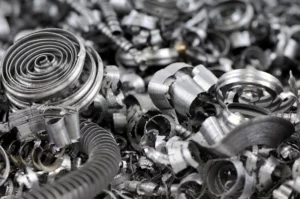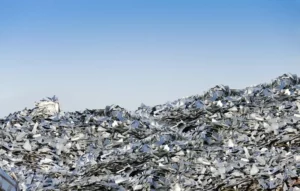If you collect and sell scrap metal—or if you work in a manufacturing facility that generates scrap metal—you’ve likely heard scrap as being divided between ferrous and non-ferrous metals. While this might sound complicated, it’s actually rather simple. Before selling your scrap to a salvage junk yard in Clare, MI, you’ll want to know the difference between the two and how that might affect your operations. Here’s a brief rundown on the distinction between ferrous and non-ferrous metals.
The Basics
Ferrous metals and alloys contain some percentage of iron, while non-ferrous metals are iron-free. It’s that easy. Of course, you can’t tell just by looking at them, and it’s very important for junkyards to able to distinguish between the two. It’s this part of the process where things get more complicated.
Ferrous Characteristics
 Ferrous metals are by far the most common. We may not always realize it, but iron alloys are everywhere. Metals such as stainless steel, carbon steel, mild steel, wrought iron, and cast iron all contain iron to varying degrees. Iron helps give these materials an impressive tinsel strength and durability and is why they’re commonly used in structures as diverse as skyscrapers, bridges, automobiles, train rails and other transportation services, industrial containers, piping and even household appliances and hardware. Due to the fact that ferrous metals usually require a lot of carbon in their formation, they tend to rust. While this isn’t the case with wrought iron (nearly pure iron) or stainless steel (due to a high chromium content), if you see metal that’s rusting, it’s most likely a ferrous metal.
Ferrous metals are by far the most common. We may not always realize it, but iron alloys are everywhere. Metals such as stainless steel, carbon steel, mild steel, wrought iron, and cast iron all contain iron to varying degrees. Iron helps give these materials an impressive tinsel strength and durability and is why they’re commonly used in structures as diverse as skyscrapers, bridges, automobiles, train rails and other transportation services, industrial containers, piping and even household appliances and hardware. Due to the fact that ferrous metals usually require a lot of carbon in their formation, they tend to rust. While this isn’t the case with wrought iron (nearly pure iron) or stainless steel (due to a high chromium content), if you see metal that’s rusting, it’s most likely a ferrous metal.
Non-Ferrous Characteristics
The most well-known non-ferrous metals include gold, silver, copper, nickel, tin, lead, zinc, aluminum, and brass. While non-ferrous metals have their value where strength is concerned, they’re mostly in demand for what they can offer that ferrous metals can’t. Non-ferrous metals are generally more malleable than ferrous. Gold and silver can be fashioned into jewelry, for instance, due to their malleability. Non-ferrous metals are much lighter as well, which is why aluminum is so important to the airline and canning industries, and why gold is used in aerospace. Since they contain no iron, non-ferrous metals resist corrosion, so if you need a metal for gutters, pipes, roofing, road signs, you’re going to rely on non-ferrous metals exclusively. Non-ferrous metals are also non-magnetic. Whereas ferrous metals are magnetic and are frequently used in electrical appliances, large motors, and magnets themselves, non-ferrous metals’ non-magnetic properties make them ideal for small electronics and electrical wiring.
Recycling
 Ferrous metals are not as valuable as non-ferrous. Steel and iron are constantly being recycled all over the world in high volumes, they’ll never command as high a price as non-ferrous metals.
Ferrous metals are not as valuable as non-ferrous. Steel and iron are constantly being recycled all over the world in high volumes, they’ll never command as high a price as non-ferrous metals.
Of course, commodities like copper can fluctuate in price dramatically. If you want to know what your scrap metal is worth contact the professionals at Fair Salvage Company. They’re first among the local junk yards in Claire, MI, in service and will always offer a fair price. Give them a call today!

